Final report for FNE16-845
Project Information
This project sought to test the value of two separate approaches to improve soil health on a conventional dairy farm in Maine growing corn and mixed grass/legume forages.
The first experiment compared whether fall drilled or spring frost seeding worked better to seed down a field to grass/legume during a crop rotation cycle. Unfortunately as deployed, both seeding methods failed. The drilled seeding produced weak results and the frost seeding delivered zero results. An unexpected discovery was that triticale, used as a winter cover crop on both drilled and frost seeded fields, had a far greater yield where the drilled seeding down had occurred. It was concluded that ancillary soil aeration produced this result. It would be beneficial for the practice of adding one or more empty drill passes over a seeding-down to be further tested to see if results are replicated.
The second experiment evaluated whether planting conventional corn through a pre-established stand of legume (hairy vetch and clover at varying seeding rates) would improve soil health and potentially reduce the need for herbicide and/or N application. The initial fall seeding down of two densities of hairy vetch resulted in a failure. As the winter rye applied at the same time did well, the most likely theory is that it was too late in the season for vetch to establish. A follow-up attempt to do a July seeding also failed due to heat and drought. At this point clover was selected to replace the vetch with another fall seeding with the rye cover crop. One of the test fields had a successful outcome and the experiment was narrowed to compare two adjacent fields. Unfortunately a mistake was made when the rye cover crop was not killed prior to manure being applied and corn planted on the test field. The cooperators monitored and documented the results through the growing season, finding that both the rye and the clover significantly suppressed the corn compared to the adjacent control field. The lack of herbicide application welcomed other weeds into the field to further compete with the corn. It was impossible to determine the relative contribution of all three factors into retarding the corn, but the corn did not do well. Soil tests were done in 2016, 2017 and 2018 with no discernible change in condition, but the clover had barely become established so some future benefit may yet accrue. While the experiment was not conducted as designed and therefore results were not conclusive, there were no encouraging signs to warrant further testing on this farm. Given the lack of conclusive results, no outreach was conducted. The difficulty of establishing an effective experiment belies any suggestion of adopting either practice in this region.
This project explored 2 questions:
First, are either or both of two forage mix seeding alternatives to late spring drilling cost-effective when rotating from corn to perennial forage? The two methods tested were (a) drilling in forage mix seed with cover crop in the fall and (b) early broadcasting just before final snow melt in spring.
Second, can seeding hairy vetch as a biannual corn cover crop along with annual winter rye produce a net gain in productivity and profitability for conventional corn fields?
As near as we can tell, while there are anecdotal tales of spring broadcast seeding attempts with a variety of results, there have been no recorded studies from which to learn. Professor Kersbergen, University of Maine, noted the lack of crop rotation on dairy land as a widespread problem at the Waldo County Cooperative Extension Annual Meeting in September 2015. He suggested that the Ward Dairy Farm take a lead in trialing these methods and consider a Northeast SARE Farmer Grant to assist with trial costs. We decided to step up to the plate.
With regard to our second experiment, it was actually while researching the SARE, National Agricultural Library and ATTRA databases on this question that the idea for trialing the application of hairy vetch with cover crop was gleaned. Specifically we were intrigued by two 2012 No-Till case studies from North Dakota written by Susan Tallman of NCAT (Brown’s Ranch: Improving Soil Health Improves Bottom Line and Richter Farm: Cover Crop Cocktails in a Forage-Based System). While both farms are ranches addressing wind erosion as a primary concern, the case studies are well documented and suggest exciting potential benefits for use in our region. Cover crops were maintained as companion plants and benefits were achieved in soil health and profitability.
Closer to home, the NESARE-funded Agroecosystems project “Sustainable Cropping Systems for Dairy Farms in the Northeastern US” completed in 2013 (led by Heather Karsten of PennState) offers compelling evidence to take crop rotations a great deal further, both with regard to the aggressive schedule of annual rotations and inclusion of grain crops to substitute for imported grain. While findings support the trialing of a wheat-red clovercorn rotation, we are not prepared to take that great of a step on our farm as yet. Perhaps we can work our way towards that goal.
The desire to substitute locally grown for imported grain is long-standing in our region, particularly among organic dairy producers. Supported by a national NRCS Conservation Innovation Grant, Professor Kersbergen worked with a number of neighboring farms in our area 10-15 years ago to trial soybeans, canola, sunflowers and wheat. Mary Ann Hayes participated as a project evaluator. While hopes were high and heroic efforts were made, yields were marginal and post-harvest time and infrastructure needs did not justify adoption. On our farm, we have focused on growing high quality forage with a 4-cut grass schedule as our best offense in reducing imported grain. No doubt more can and should be done.
On the Richter Farm, competition impacted corn yield but reduced herbicide and manure application made the field more profitable. Professor Kersbergen is concerned with potential competition with the corn. We seek to build on these studies, noting distinctions (e.g. pure harvest of a single annual crop with no follow-on grazing). We expect to follow the Tallman study method for measuring results in soil health, productivity and profitability. Going beyond the North Dakota trials, we plan to experiment with different vetch seeding rates to evaluate and document the relative trade-offs. Is there a sweet spot? In addition, the potential for longer-term soil improvement will be projected, with its implications for future crop yields.
In determining which methods to trial, we felt limited by access to sufficient land to experiment with an entire new crop (wheat) and by the wishes of the owners of the fields that we lease to keep their land in perennial grass. We have to limit our risk exposure to low yields, low quality or failed seedings to ensure we have sufficient quality feed for our cows. We had hoped that this trial of extending a cover crop as a nitrogen-fixing companion plant will take us a step in the right direction. We selected the hairy vetch for trial, but will keep the findings of the Karsten report in mind, which found advantages of red clover over vetch when used as a harvested annual rotation crop (slightly different application than non-harvested cover and companion plant in a longer rotation cycle where seed persistence of the vetch is not a concern). If we recognized similar results in 2017, our plan was to decide to add a field with winter rye and red clover in 2018 to the trial.
Cooperators
- - Technical Advisor
Research
Project Management:
The project team assembled in early April 2016 to revisit objectives, timelines and roles. Existing soil samples were reviewed and determined to be adequate for baseline until September corn/vetch field samples were to be taken.
Experiment #1: Seeding Down Alternatives:
Our intent was to measure the planting densities of both clover and tall fescue on five fields, comparing the results of fall drilling (done 10/2/15) vs. snowmelt broadcasting (2/26/16). Enhance Brand Tall Fescue was planted at 20 lb/acre. Red clover was planted at 2.78#/acre. Triticale was drilled as a cover crop in the fall at the same time and rate of 122 lb/acre on all fields.
We took 2 measurements during May 2016. Fescue and clover plants were counted within 3 random 2 square foot plots in each side of each field (total of 24 plots, 12 each of fall drilled vs. frost-seeded).
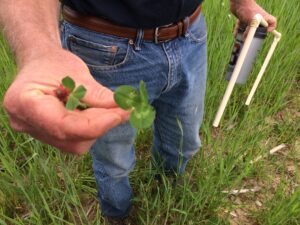 One of few clovers counted and random plot-finding tool used
One of few clovers counted and random plot-finding tool used
The first was on May 9 when the triticale was about 3” high. The observations were generally discouraging; fescue and especially clover counts were very low. We were hopeful that more plants would emerge by later in the month. It became clear that one field had been mistakenly planted on the same side both in the fall and the spring. This field was taken out of the experiment.
The second set of counts was done on May 24, 2016 when the triticale was 12-16” high and almost ready to harvest. It was clear that the February 28 frost seeding had failed, likely due to the severe up and down temperature swings during March and April since the seeding. While the fall-drilled plant counts were somewhat higher than they had been on May 9, they were still extremely disappointing. Very few clover plants had emerged. We determined that a higher seeding rate would be employed in the future. The raw counts were as follows: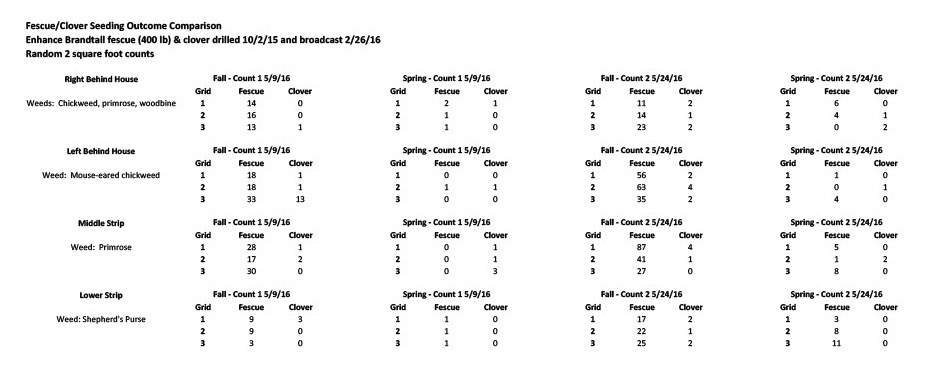
The triticale, on the other hand, had done very well. It was noted that the same planting pattern had been employed for drilling the permanent and cover crops, and that the triticale had apparently out-competed the fescue and clover in what were often about the same planting row. It was noted that it would be preferable to change planting direction as much as possible to prevent this possible hindrance to success. The impracticability of achieving this objective on many fields was also noted.
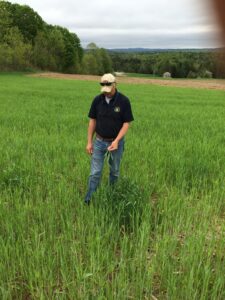 Triticale evaluated on May 24, 2016: Ready to harvest.
Triticale evaluated on May 24, 2016: Ready to harvest.
Regarding the triticale, the team witnessed a surprise finding on May 24. Across all 4 fields, the triticale was 25% taller on the side where it had been run over again with the drill seeding (see photo). The theory is that the aeration with the drill released more nitrogen to those seeds. It was further noted that there were plentiful worm middens, a testament to the general success of the no-till planting that had been employed on these fields for the last several years.
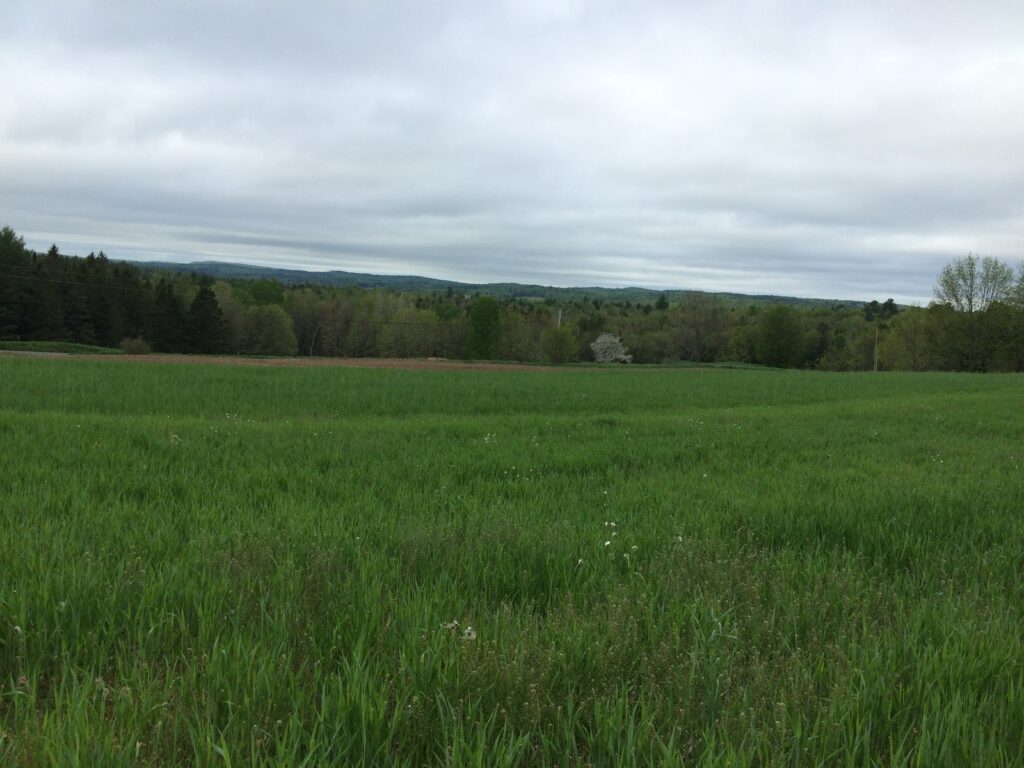 Unexpected Discovery: Triticale 25% higher where followed with drill
Unexpected Discovery: Triticale 25% higher where followed with drill
The triticale was harvested on May 26; this went well. It became clear that all 5 fields had a failed seeding down and it was agreed to reseed. It was also agreed that the farm could not afford to do a second year trial of fall drilling vs. frost broadcasting. All further seeding would be by drill (still committed to no-till). The ongoing comparative yield data that had been planned could not be completed.
Then, very unfortunately, the lack of rain resulted in a second crop failure on all 5 fields. A summer forage seeding of sorghum-sudangrass was considered but rejected. Advice was taken to cancel the remainder of Experiment #1 and focus on Experiment #2. The 5 fields were treated with glyphosate and seeded a third time on August 20, 2016 when rain that had been forecast came up short of expectations. This time a more diverse seed mixture was used to further reduce risk (Seedway 350 Haymaster Mix: 35% Premium Tall Fescue, 30% Premium Orchardgrass, 15% Red Clover, 10% Perennial Ryegrass & 10% Festulolium planted at 36#/acre, slightly higher than the recommended 30#/acre). Clearly, this failure was very expensive and a reminder of the crop rotation risk factor. While not foreseeable, 2016 was a record drought year in Maine. No one we know of had a successful perennial grass seeding down experience.
Experiment #2: Hairy Vetch Planted with Corn:
On September 20, 2016 we marked out the fields for the corn/vetch trial and took baseline soil samples. The fields were divided into two similar halves (one upland and one lowland), and then again in thirds. Each sample field is about 1.75 acres in size. Tree flags were marked to identify the plots and a diagram was made. Winter rye was planted uniformly at 75 lb/acre across the entire area. Vetch was planted at 10 lb/acre on one pair of thirds and at 15 lb/acre on another pair. The final third of each field was left as the control.
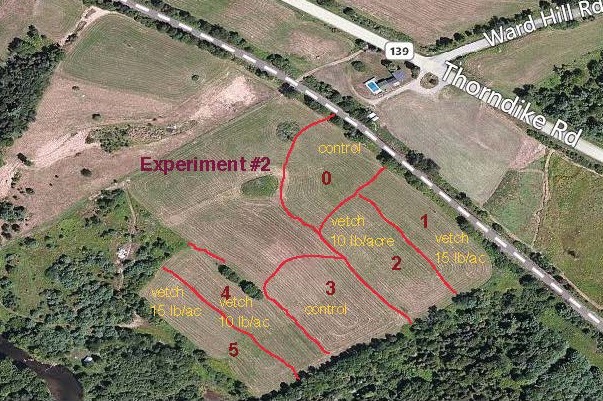 Experiment #2 Field Layout
Experiment #2 Field Layout
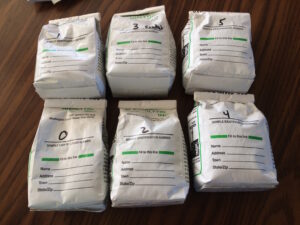 Baseline Soil Samples
Baseline Soil Samples
2017:
We started with a very wet spring. All field work was delayed. We harvested grass before planting corn, the reverse of our normal approach. One unexpected benefit was that we harvested the rye cover crops on all corn fields for forage rather than kill it as it was too mature to kill.
The project team and advisors met on the Wentworth Experiment #2 fields to confirm whether the fall-seeded vetch had emerged. It was agreed that we had birthed another total seeding down failure. In comparison, the winter rye which had been planted on the same date in the fall was thriving.
It was agreed that we would try again after the corn was planted and sprayed as otherwise the vetch seedlings would be killed. Given that the distinctions between the seeding down rates as originally proposed seemed like a weak comparison experiment with zero germination from 2016, the team conducted further research on cool weather legume cover crops and decided to compare white clover with the hairy vetch at the same rates of about 14 lb/acre (50 lb bag of each distributed over the approximately 7 acres of fields).
An effort was made to secure a high boy interseeder but that proved unsuccessful. The seeding down of clover and vetch was done on July 14 via broadcast seeder as drilling would have disturbed the more valuable corn seedlings. Unfortunately the fields had gone from very wet to very dry in the space of 10 days and another summer drought ensued.
Very little sign of clover or vetch was seen as the corn matured. After the corn was harvested, the soil was again sampled and clover and vetch seedlings counted. Virtually zero vetch had come up. Some clover was present. The team will give it more time to emerge in the spring and assess what we have to work with for 2018.
While the soil sample readings were logged and compared, there were no conclusions that could be drawn. There was very little legume present to influence soil health outcomes in 2017.

2018:
In early May, the fields were scouted and results were disappointing. Only Field 5 had yielded a reasonable amount of clover. Very little vetch or clover had emerged on the other 3 planted fields. It was decided to narrow the experiment to just the adjacent portions of Fields 4 and 5 where the clover had emerged and other field conditions were very similar.
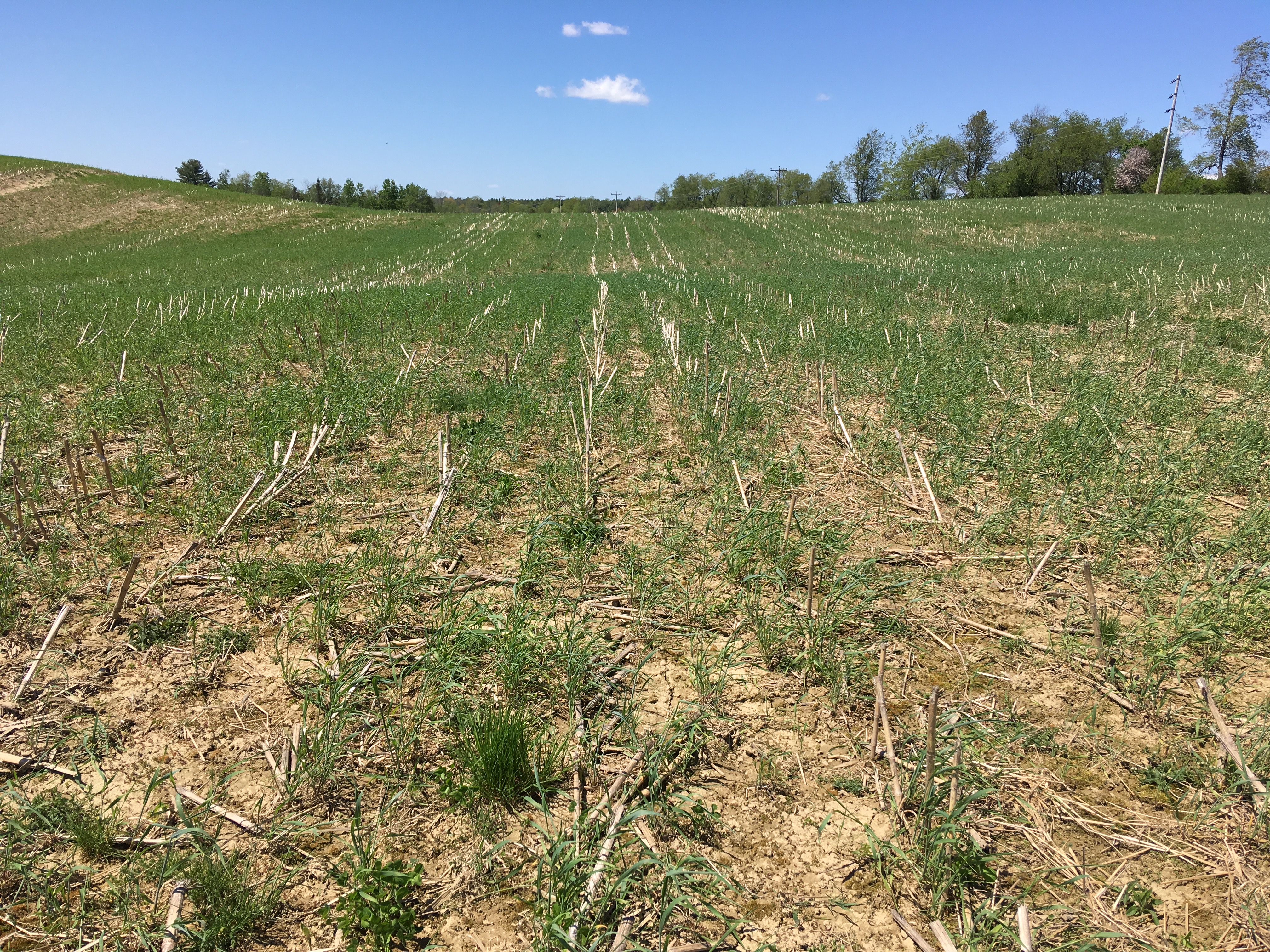
Then a mistake was made. On May 21, both Fields 4 (the new control) and 5 were covered in manure and planted into corn on May 24. Instead, Field 5 should have been treated with Intensity One pre-emergent to kill the rye but not the clover. As that mistake was digested by the team, it was decided to move forward to adjust the experiment to see how the corn would do with the rye and clover untreated. For the first month, it appeared that the corn was holding its own against the control field.
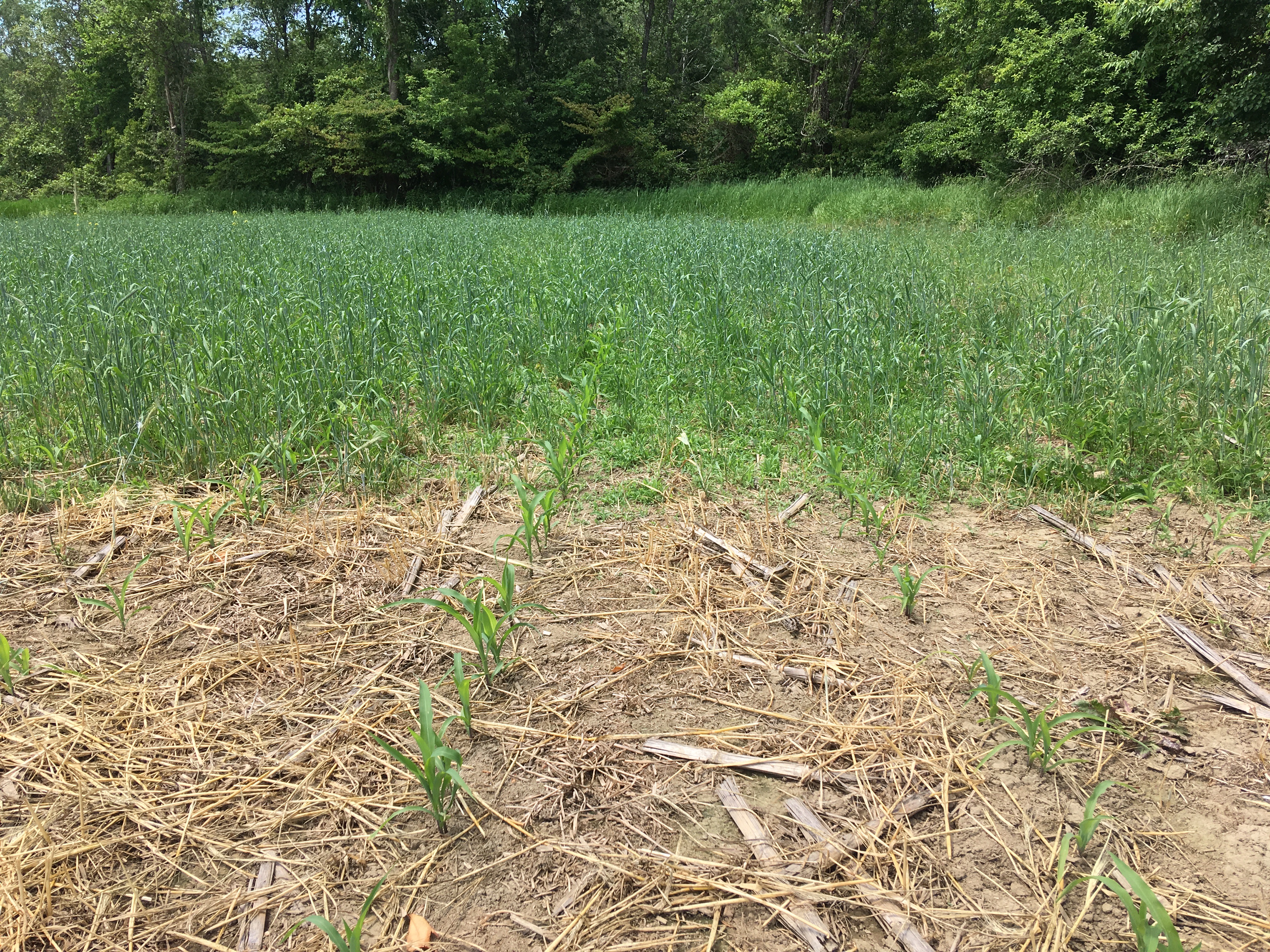
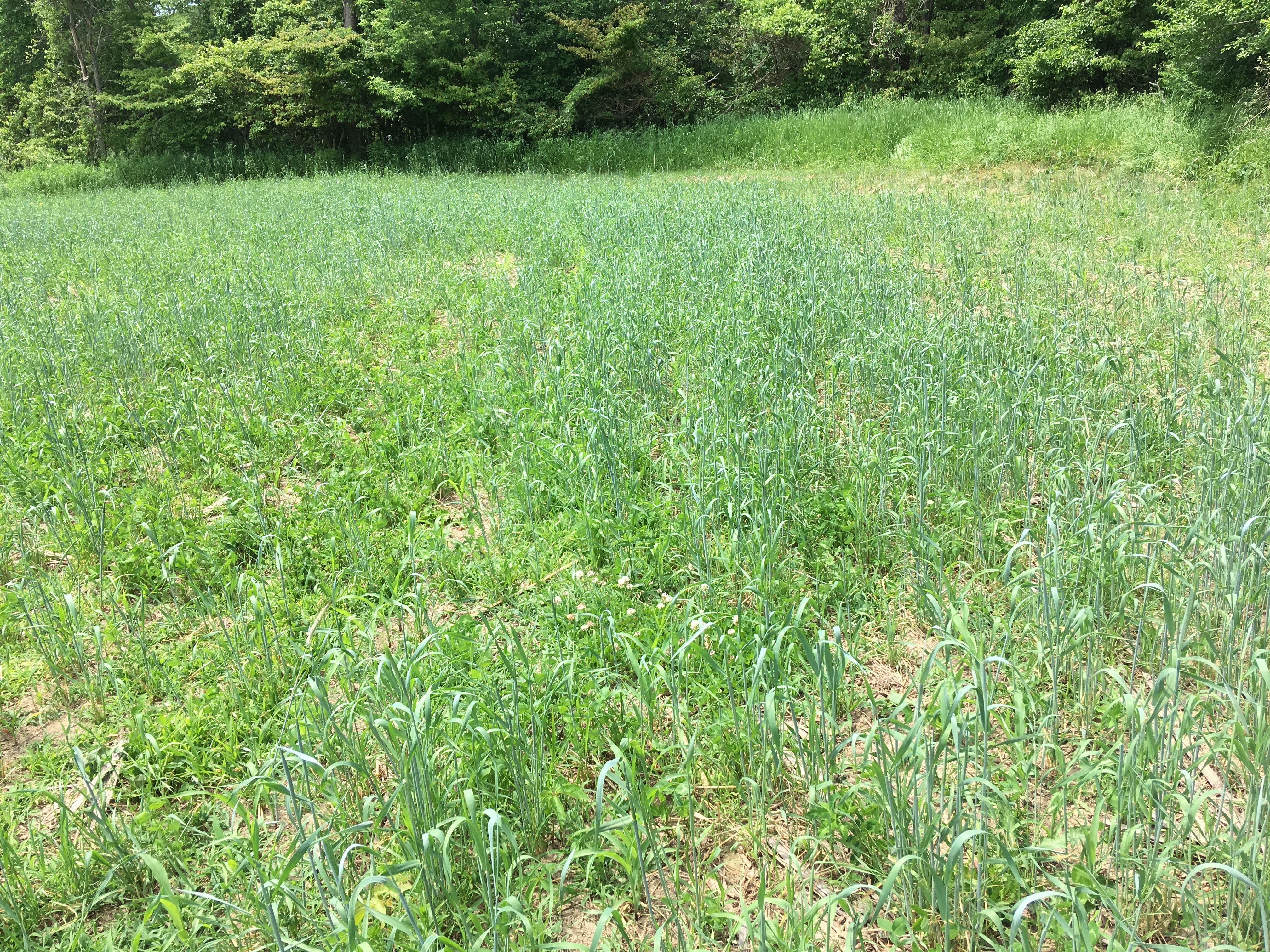
By early July when fields were tested for Nitrogen, this scene had changed dramatically. The rye was choking the corn and clover was growing well even though hot weather had begun. Field 5 was found to need twice the N added than the control field (110 lb/acre instead of 55 lb/acre). This seemed ironic given the clover planting but essentially it was too soon for the clover to have fixed N and both the clover and the rye likely used N compared with the control field with only corn growing since late May. It was decided to apply a light coat of glyphosate to kill the rye but not the clover to save the remainder of the experiment and give the Field 5 corn a chance.
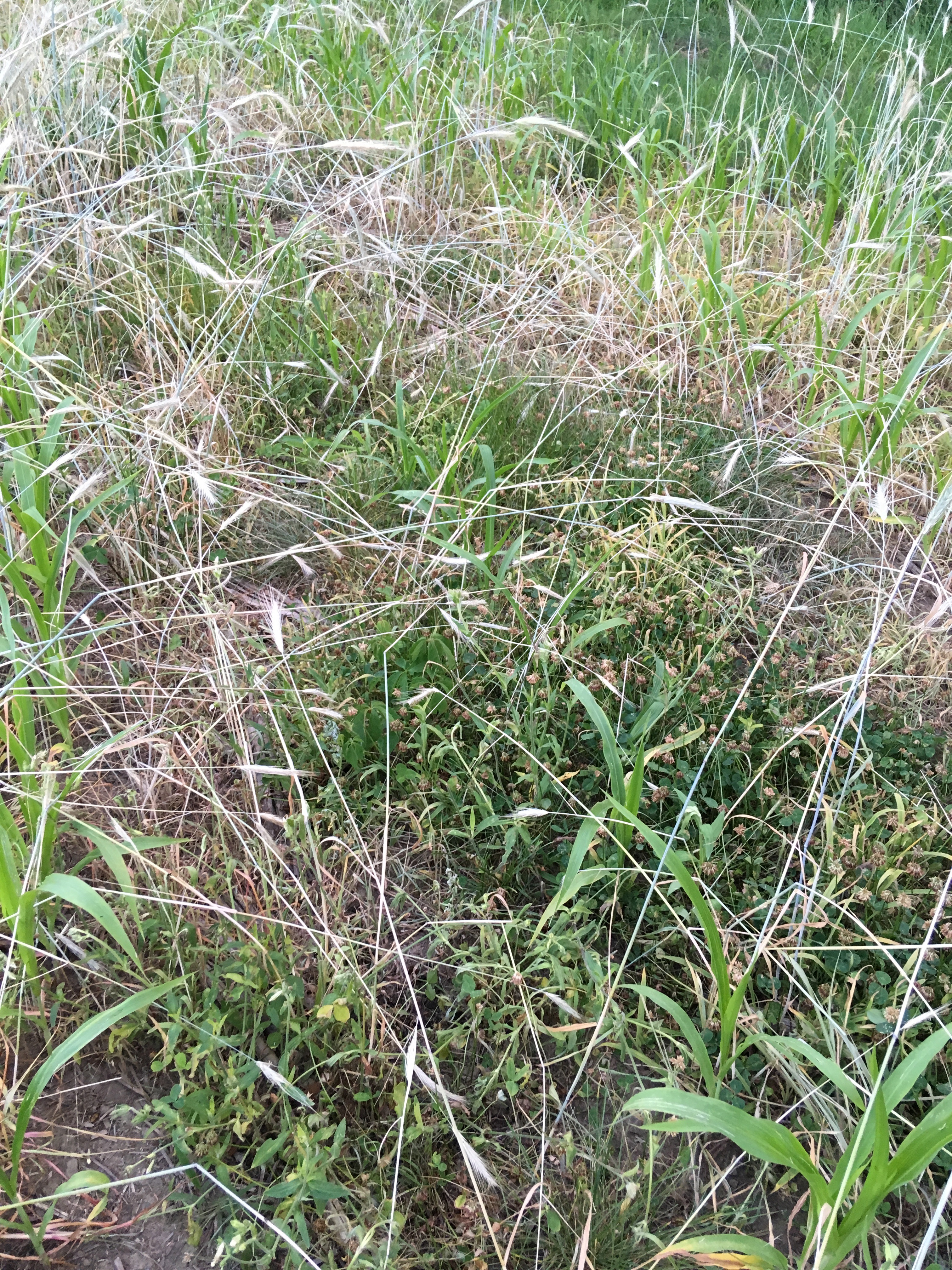
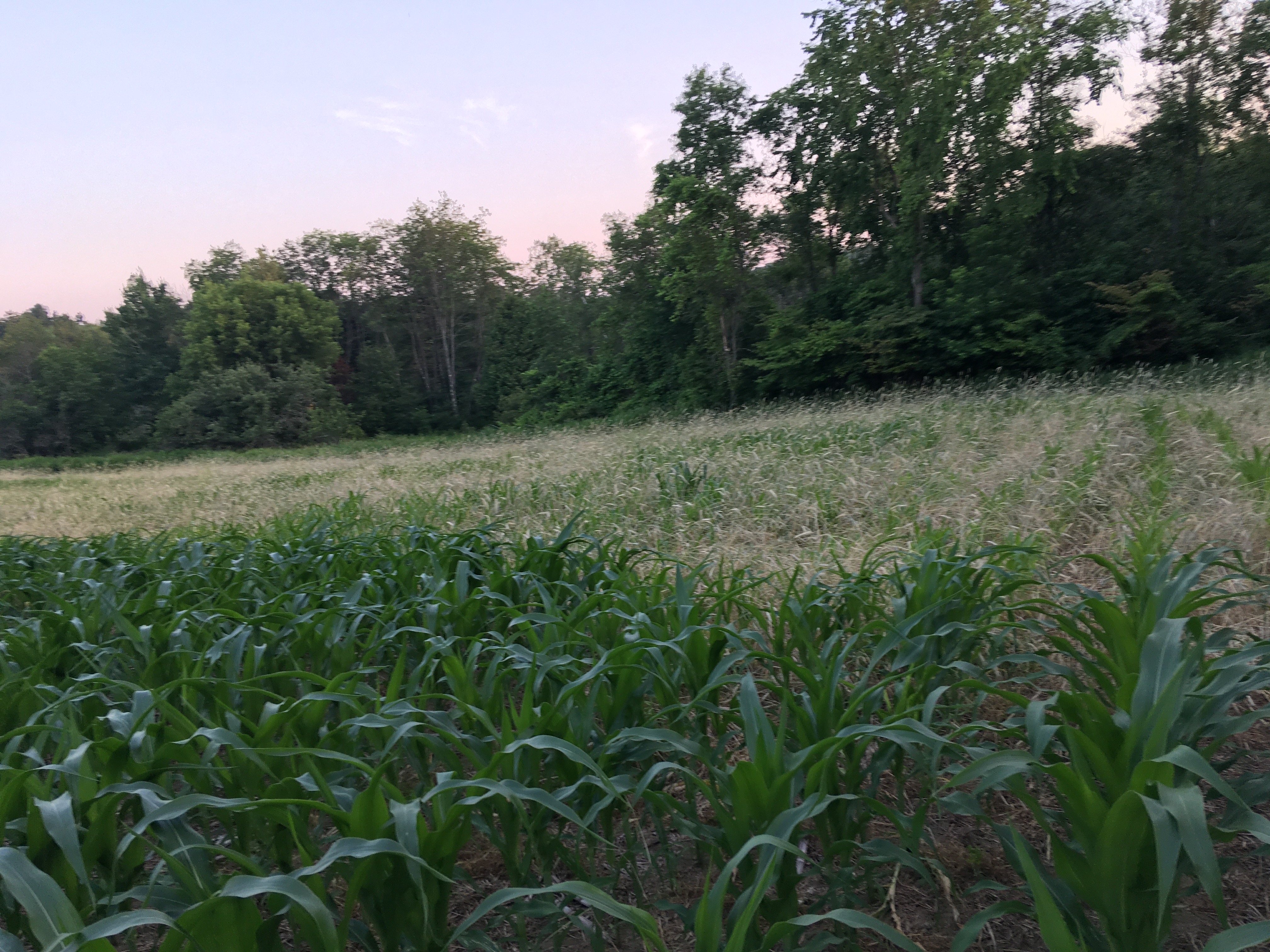
Over the rest of the summer, the control field continued to thrive while Field 5 struggled and never caught up.
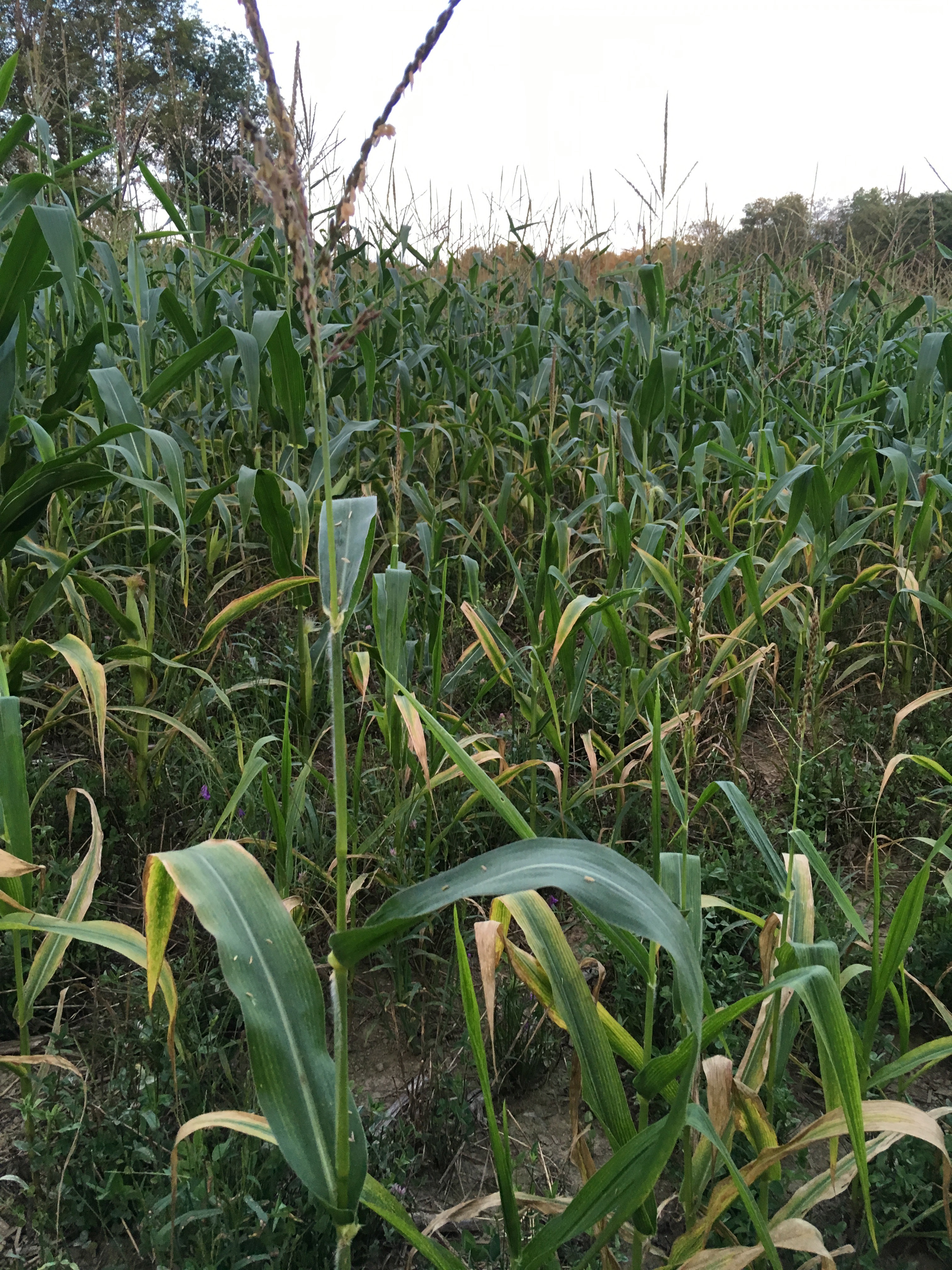
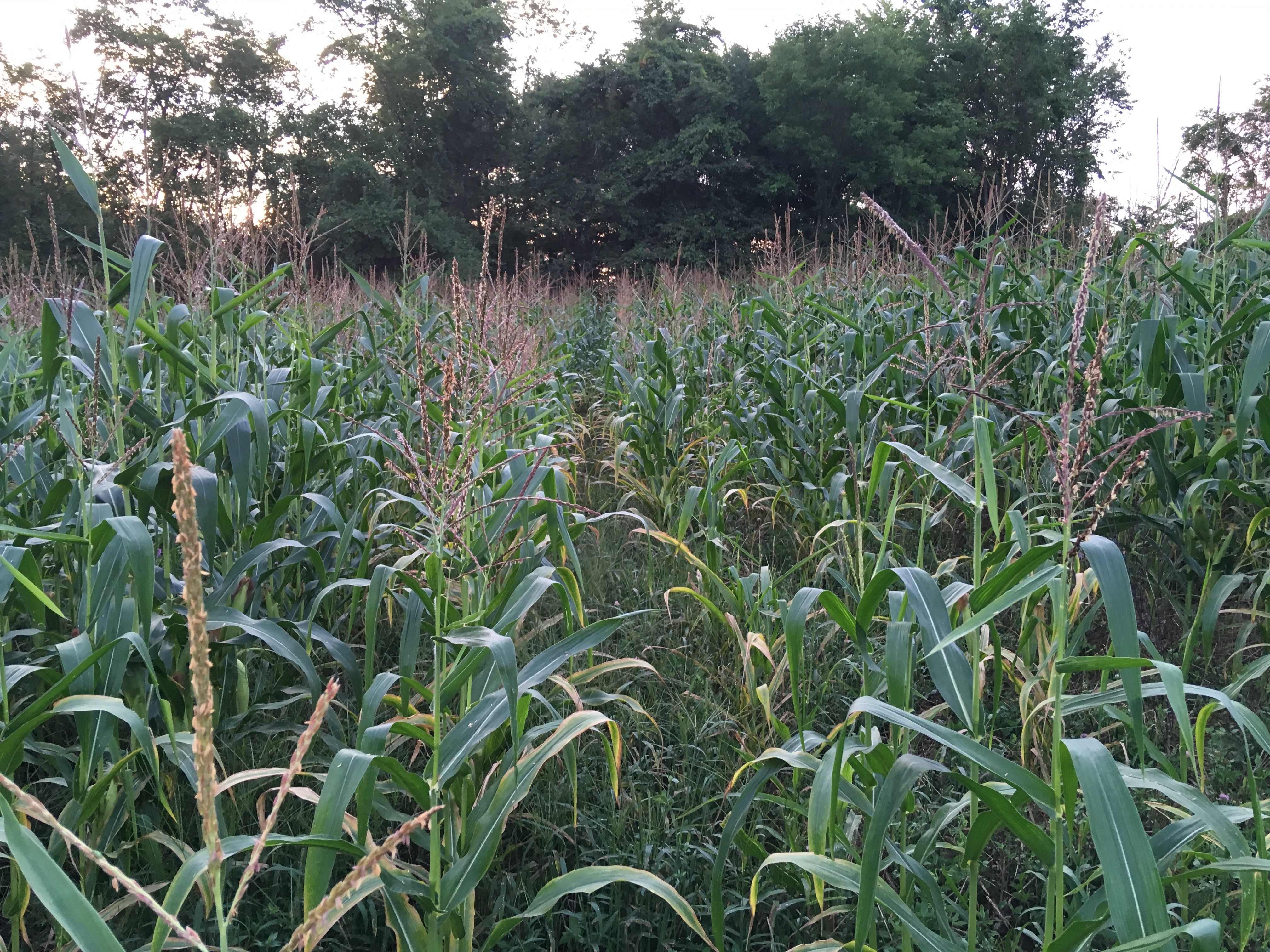
On September 17 ahead of harvest, the team measured the yield of the two fields. 1/1000th of an acre strips of corn were cut in the test area and the check area. The difference between the two was starkly different.
In Field 5 (treatment area) 15 lb. of corn stalks were measured, which equates to 7.5 tons per acre corn silage. In the Field 4 (control area), we measured 38 lb. of corn stalks, which equates to 19 tons per acre corn silage.
ALSO, for whatever reason, the maturity in the treatment area measured somewhat behind the maturity in control. This means that if we adjusted for moisture we would have an even greater difference between the two.
Clover was moderately well established in the treatment area. Weed control in both areas was very good at this point over two months post glyphosate treatment.
In early October the corn was harvested and the soil tested on October 7. The pH was unchanged in both fields since the 2016 baseline. Moisture was up slightly but 2016 and 2017 were drought years and 2018 wetter so not possible to compare with any degree of certainty.
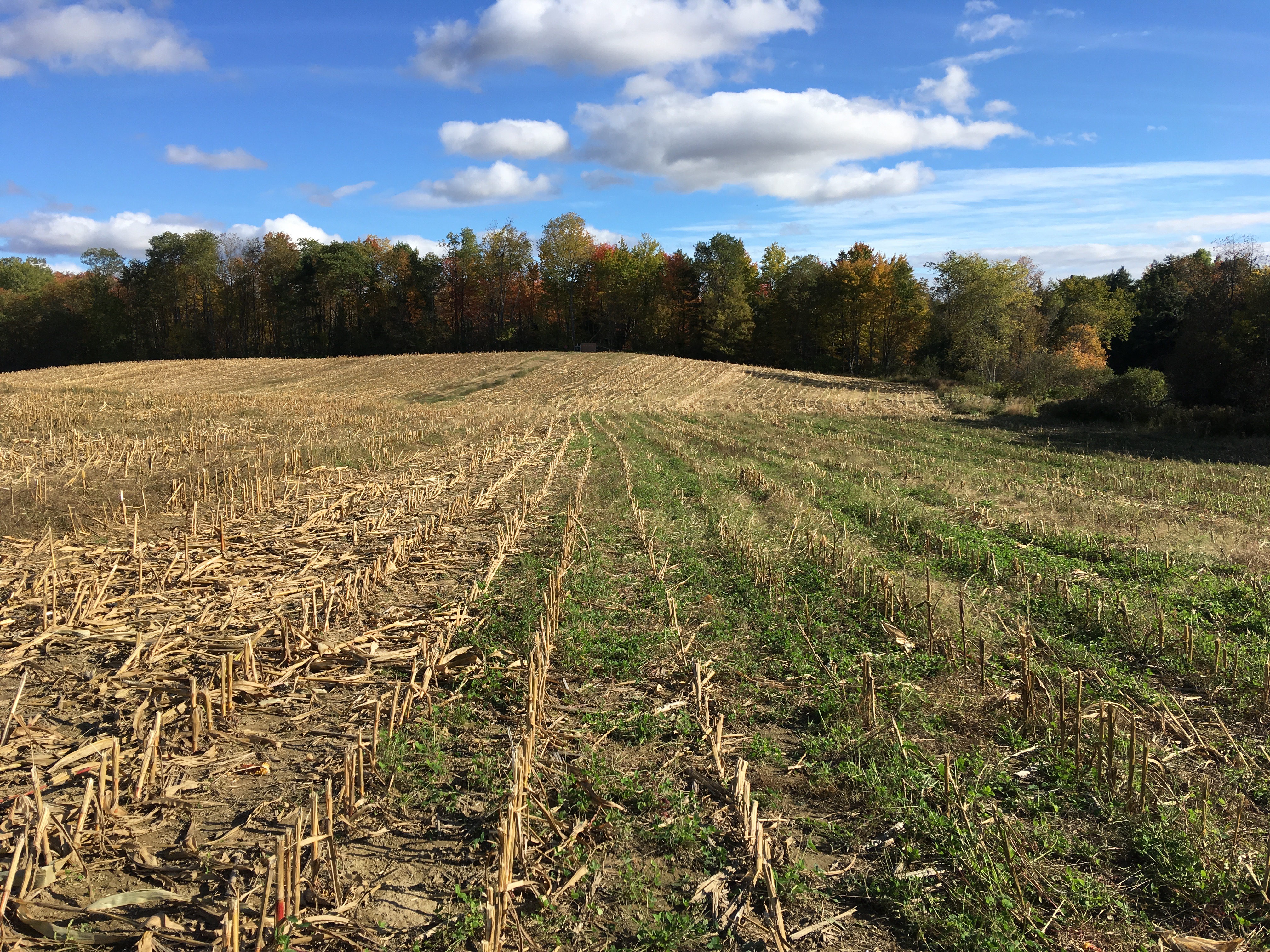

Both experiments were flawed due to failed seedings, largely attributable to back-to-back years of drought conditions. Adjustments were made to salvage valid experiments. A final mistake was made in May of 2018 when manure was applied to the treatment field ahead of herbicide, which needed to be applied pre-emergent.
The legume interplanting theory can neither be proven nor disproven based on this research project. However the difficulty in creating the experiment conditions needed to conduct the research signals that it would be difficult to rely on this approach as a standard practice at this time.
Accomplishments
- The wider variations in climate (temperature and water), while favoring no-till planting, render all seeding applications at higher risk than historical averages.
- The frost seeding method becomes especially prone to risk so will not be recommended unless a reliable weather forecast underwrites it.
- The use of a drill as a substitute aerator to release soil N or other nutrients following seeding is worth further exploration.
- Vetch is difficult to establish in this region. Clover was successfully planted on one of two experiment fields.
- It is worth killing winter rye, which severely impacted corn growth.
- The potential benefits of clover establishment with corn were not evident in corn yield or soil quality during this growing season. The clover likely competed with the corn along with the rye, resulting in significantly lower yields than standard practice.
Education & Outreach Activities and Participation Summary
Participation Summary:
Unfortunately, due to flaws in weather and implementation, neither experiment warranted a tour, journal article or other education or outreach activity. Thus, we are counting only one farmer (us) and one ag educator (Rick Kersbergen) as experiencing "outreach".
Learning Outcomes
- The significant increase in yield of triticale cover crop apparently from aeration due to drilling suggests that a preliminary pass of empty drilling in a different direction than the one in which seed is sown may increase plant growth. Many fields are unfortunately limited in what direction equipment can be driven but this will be worth trialing further.
- The accidental harvesting of winter rye cover crop to use as forage due to the wet spring has presented itself as valuable forage. In the future, we will purposefully plan to harvest the rye as forage and plant short-season corn.
- The difficulty in establishing vetch as a cover crop renders it unsuitable for our region.
- While the corn-legume interseeding experiment was not performed as originally designed, initial findings suggest that the clover competes with corn for nutrients with a negative impact on yield. No improvement in soil health was noted after the first season of clover establishment. Conventional use of herbicides and application of N following PSNT analysis delivers consistent successful results for corn yield and will be continued.
Project Outcomes
This research suggested we should stick with the tried and true. No new knowledge to share or promote.